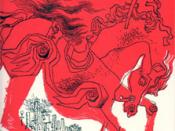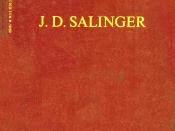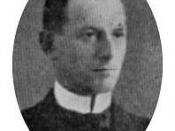Thesis Statement: In The Catcher in the Rye, J.D. Salinger uses symbolism, narrative techniques, and attitude/tone to generate the main character's feelings toward life's inconsistencies.
I. Introduction II. About Salinger A. Personal information B. Style III. Symbolism A. The ducks B. The Museum of Natural History C. Allie IV. Narrative techniques A. Structure 1. Exposition 2. Rising action 3. Climax 4. Falling action 5. Conclusion B. Point of view C. Formal/Informal V. Attitude/Tone A. Phoniness B. Characters 1. Holden 2. Holden's family a. Mr. and Mrs. Caulfield b. Phoebe 3. Pencey students VI. Detail A. Amount B. Relevance C. Effect VII. Conclusion Catcher in the Wry The Catcher in the Rye written by J.D. Salinger, is both praised, and rejected as a classic of American literature. While multiple literary elements are used in the book, none are more prominent than the use of symbolism, motifs, and attitude/tone.
J(erome) D(avis) Salinger was born January 1, 1919 in New York city.
He is a divorcee of Claire Douglas, with whom he bore two children, Margaret Ann, and Matthew Salinger. Salinger joined the United States Army in 1942 until 1946, during which he was awarded five battle stars and reached the status of staff sergent.
Salinger's works were generally written during two time periods, World War II, and the 1960's. Critics feel that the works in the 1960 time period were very inappropriate, due to the problems he wrote of. It is said that he "... created the dialect of a generation." (Riley 998) The protagonists were generally social misfits. In most of his works, the main character seeks out happiness. However Salinger does not conform to material happiness; his characters undergo a spiritual happiness. They generally start out in horrid conditions, but by the end of his works, they have undergone...


